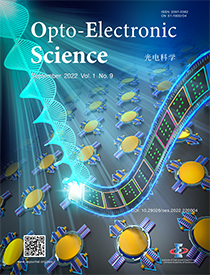2022 Vol. 1, No. 9
Cover story: Meng WJ, Hua YL, Cheng K, Li BL, Liu TT et al. 100 Hertz frame-rate switching three-dimensional orbital angular momentum multiplexing holography via cross convolution. Opto-Electron Sci 1, 220004 (2022).
Holographic technology shows great potential in data storage, three-dimensional display, and artificial intelligence, etc. The theoretical unbounded physical dimension of the orbital angular momentum (OAM) has been used as an information carrier in holography, resulting in the concept of OAM holography. However, the state of the illumination beam in the traditional holographic decoding process is based on phase modulation, resulting in a long switching time (generally no more than 30 Hz). The switching rate is physically determined by the switching speed of the illumination beam state. Currently, it is limited by the refresh rate of the phase-modulated spatial light modulator, which limits the future development of ultra-high-speed OAM-addressable dynamic holography.
This cover paper proposes a new concept of cross convolution aiming at high-speed extracting information from the OAM multiplexing hologram. They design a special amplitude-modulated pattern to illuminate the hologram in order to extract a specific picture based on the cross convolution relation between a series of spatial frequency components of the amplitude-modulated pattern and the OAM-multiplexing hologram in spatial frequency domain. With the help of the digital micromirror device, the amplitude-modulated pattern can be loaded and switched on the illumination beam at a frame rate of several kilohertz, so that holographic video can be played at this frame rate by using this technology which leads to a two-orders of magnitude increase of information extraction speed in OAM holography in principle. In their experiment, the significant digits of the value are encoded in the hologram, and they show that the first 100 significant digits are emerged quickly at a speed of 100 Hz as shown in the figure. The typical example of high-speed reconstruction of digits proves that the scheme can not only support holographic video, but also show the potential in construction of a high-capacity short-range optical communication system.
Back cover story: Jiao SM, Liu JW, Zhang LW, Yu FH, Zuo GM et al. All-optical logic gate computing for high-speed parallel information processing. Opto-Electron Sci 1, 220010 (2022).
Optical computing and optical neural network have gained increasingly more attention in recent years because of its potential advantages of parallel processing at the speed of light and low power consumption by comparison with electronic computing. For both electronic and optical implementations, analogue computing and digital computing are two fundamental options. The optical implementation of the fundamental building blocks of a digital computer, i.e. logic gates, has been investigated extensively in the past few decades. Various optical logic gate schemes including spatial encoding of light field, semiconductor optical amplifiers (SOA), highly nonlinear fiber (HNLF), microscale and nanoscale waveguides, and photonic crystal structures have been extensively attempted. This paper provides a comprehensive survey of these latest developments of optical logic gate computing with different kinds of schemes. There are still many formidable challenges in developing practical all-optical logic gates and more advanced optical logic gate computing systems remain to be further explored in the future. It is favorable that a photonic chip integrated with massive optical logic gates can be eventually implemented with novel silicon photonics technologies.

-
{{article.year}}, {{article.volume}}({{article.issue}}): {{article.fpage | processPage:article.lpage:6}}. doi: {{article.doi}}{{article.articleStateNameEn}}, Published online {{article.preferredDate | date:'dd MMMM yyyy'}}, doi: {{article.doi}}{{article.articleStateNameEn}}, Accepted Date {{article.acceptedDate | date:'dd MMMM yyyy'}}CSTR: {{article.cstr}}
-
{{article.year}}, {{article.volume}}({{article.issue}}): {{article.fpage | processPage:article.lpage:6}}. doi: {{article.doi}}{{article.articleStateNameEn}}, Published online {{article.preferredDate | date:'dd MMMM yyyy'}}, doi: {{article.doi}}{{article.articleStateNameEn}}, Accepted Date {{article.acceptedDate | date:'dd MMMM yyyy'}}CSTR: {{article.cstr}}

 E-mail Alert
E-mail Alert RSS
RSS



